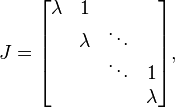Defective matrix
In linear algebra, a defective matrix is a square matrix that does not have a complete basis of eigenvectors, and is therefore not diagonalizable. In particular, an n × n matrix is defective if and only if it does not have n linearly independent eigenvectors.[1] A complete basis is formed by augmenting the eigenvectors with generalized eigenvectors, which are necessary for solving defective systems of ordinary differential equations and other problems.
A defective matrix always has fewer than n distinct eigenvalues, since distinct eigenvalues always have linearly independent eigenvectors. In particular, a defective matrix has one or more eigenvalues λ with algebraic multiplicity  (that is, they are multiple roots of the characteristic polynomial), but fewer than m linearly independent eigenvectors associated with λ.[1] However, every eigenvalue with multiplicity m always has m linearly independent generalized eigenvectors.
(that is, they are multiple roots of the characteristic polynomial), but fewer than m linearly independent eigenvectors associated with λ.[1] However, every eigenvalue with multiplicity m always has m linearly independent generalized eigenvectors.
A Hermitian matrix (or the special case of a real symmetric matrix) or a unitary matrix is never defective; more generally, a normal matrix (which includes Hermitian and unitary as special cases) is never defective.
Jordan block
Any Jordan block of size 2×2 or larger is defective. For example, the n × n Jordan block,
has an eigenvalue, λ, with multiplicity n, but only one distinct eigenvector,
Example
A simple example of a defective matrix is:
which has a double eigenvalue of 3 but only one distinct eigenvector
(and constant multiples thereof).
See also
Notes
- ↑ 1.0 1.1 Golub & Van Loan (1996, p. 316)
References
- Golub, Gene H.; Van Loan, Charles F. (1996), Matrix Computations (3rd ed.), Baltimore: Johns Hopkins University Press, ISBN 0-8018-5414-8
- Strang, Gilbert (1988). Linear Algebra and Its Applications (3rd ed.). San Diego: Harcourt. ISBN 970-686-609-4.



